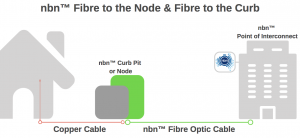NewSprout Support Articles
Replacing internal copper wiring can improve your nbn™ FTTN and FTTC speeds and consistency
FTTN uses the existing copper phone line – up to a few hundred metres in some cases (from your phone outlet to the node).
FTTC is laid right up to your driveway or curb, and then only the last bit of copper phone line to your house is still used.
In both cases Fibre Optic cable then takes over to the wider nbn™ network.

It is true that old or poorly installed in-home wiring (or any unused or damaged outlets), can negatively impact the speed, stability and overall quality of your nbn™ VDSL connection.
It could be old and in poor condition, or even half chomped through by vermin.
In addition, the quality and age of the copper (and connections) from the outside of your home to the nbn™ Node or Pit on the curb can also impact your speed and stability.
In Australia, before and during the nbn™ rollout, we have been left with a legacy of a Telecommunications provider who neglected to adequately maintain the copper infrastructure around the country. Much of that copper that was originally only designed and laid in the ground for simple voice services is 30+ years old, has been patched up more than a 5 year olds knee. Regular storm damage, often submersed in briny pools of storm water and salt water, causing electrolysis and rotting of cables and joints. We know only too well from ADSL issues, that when copper gets moist or wet it eventually degrades the quality of the signal.
This leads to poor speeds and dropouts. As more water gets into the copper line it eventually degrades completely and needs to be replaced.
Never mind the fact that Australian infrastructure has not had any future proofing or plans in place to keep abreast with the rest of the world, it has not even had the required maintenance to keep the older ADSL technologies working properly. This was the result of a monopoly having control of our internet infrastructure.
The nbn™ is a good step forward in getting us back on track and despite the bad decisions and the politics, it will improve. The FTTN and FTTC areas would be a whole lot better once the dull fragile copper is replaced with shiny new lengths of copper or even Fibre.
This is direct from nbn™ themselves in 2017…
“In-home wiring – the copper cabling that runs to and between telephone sockets in the vast majority of homes – can have a very real impact on the quality of service that end users experience … after an internal study we conducted earlier this year on nearly 800 premises found that, of those studied, speed performance issues identified in one in two premises on Fibre-to-the-Node networks were caused by in-home wiring. In many of these cases poor wiring caused download speeds to degrade by more than 50 per cent.
With good in-home wiring, there should be little to no impact on your nbn VDSL service. But in cases where wiring is old, poorly put together or where unused telephone outlets are still wired to the main system, this can lead to speed degradation and cause drop-outs.Thankfully, there can be a relatively simple fix for homes suffering from speed degradation caused by poor wiring. The range of solutions includes moving your modem to the first socket, closing off unused phone outlets, installing a central splitter, or re-cabling poor wiring.In fact, our study found that the above simple fixes resulted in an average speed increase of 55 per cent (from 30Mbps to 46Mbps download speeds).”
Source: https://www.nbnco.com.au/blog/the-nbn-project/nbn-to-trial-new-in-home-wiring-diagnostic-tool (20 September 2017)
What to do? Well, there are a few potential solutions:
- Move your modem to the first outlet
- Close off unused telephone outlets – remove “star wiring”
- Re-wire internal phone wiring
- Consider replacing the copper from your home to the Curb
The ideal option is to rewire a single line to your house internally. NBN FTTN and FTTC work best on a single copper line into your building. Previous home installations would often have what is called “star wiring” with multiple phone outlets. This should be removed and reduced to a single wire.
You can think of star wiring a little like a garden hose with multiple connectors to sprinklers off the same line. It not only reduces the main line pressure, but if one of the other lines is blocked or kinked it can cause back-flow further reducing the main line effectiveness. Star wiring can loosely be compared to this, where your main copper line into the house can be effected by multiple lines.
It can often go unnoticed, however it can cause unpredictable behaviour.
If you are unsure, give a data electrician a call for an on site visit and advice.
Any questions please get in touch: support@newsprout.com.au
24/7 Email Support
Support@NewSprout.com.au
Response time: less than 58 minutes
Call 02 6687 6533
Speak to our Australian Support team
8:30am - 5:30pm AEDT
